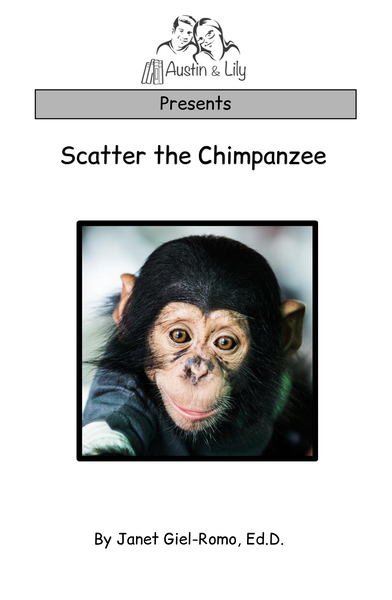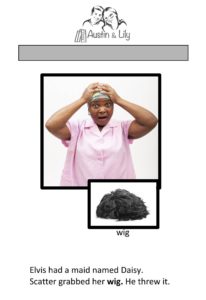Developing self-determination skills is a major priority when it comes to teaching students with intellectual disabilities. What helps is getting a really good feel for how to identify teachable moments so that students get a lot of support and practice developing these skills. By providing context for the issues that are being discussed, comprehension goes way up along with generalization.The situations occuring in our units are ideal because they eliminate the abstract nature of random “pretend scenarios” on flashcards. I’m always on the lookout for teachable moments to incorporate into our units. I can’t tell you how excited I was when I started working on our Elvis Presley biography and learned that he had a pet chimpanzee. As I read more about Scatter, I realized that he needed his own book.
A bit about Scatter:
Scatter was Elvis Presley’s pet chimpanzee. He wore clothing and lived at Graceland. In the end, he was not able to live there anymore because he made so many bad decisions.
Scatter could be quite naughty- Stephanie’s students gasped at some of his horrible decisions!
Scatter bit the butler, pulled the maid’s wig off, and pulled the curtains off the windows at a hotel. And…. that is just to name a few of his antics.
Here is a sample group discussion from the page where Daisy’s wig is grabbed and thrown
Teacher:
This is a wig. Please point at the wig. What is a wig? Where does a wig go? Why do people wear wigs? (concept of what a wig is and why they are worn)
This lady was Elvis’ maid. Her name is Daisy. Please point to Elvis’ maid. What is her name? Being a maid is a job. Daisy worked at Elvis’ house. She worked as a maid. She got paid to work as a maid. What does a maid do? Why do some people have a maid? (concept of what it means to be a maid)
Daisy was wearing a wig. What happened to Daisy’s wig? Why did Scatter pull her wig off? Do we know for sure why he did it? (concept of motive/concept of guessing)
Do you wear a wig on your head? Do you wear a hat on your head? What if someone pulled your hat off and threw it? Would you like that? Why not? How do you think Daisy felt? Do you think Daisy may have felt embarrassed? Embarrassed is how Daisy might have felt. Maybe Daisy did not want anyone to see her without her wig. People might think she looks silly. Have you felt embarrassed before? (concept of compassion and the impact an action might have)
Poor Daisy! Her wig was pulled off. Is it easy to pull a wig off ? Is it easy to throw it? Yes. Is it funny to do that? Is it nice to do that? Why? Was throwing the wig a good idea? Did throwing the wig cause a problem? (concept of decision-making and self-regulation)
Class, Scatter grabbed Daisy’s wig. He threw it. Oh No!!! This is not good, is it????
Reflection
Developing self-determination skills in the context of curriculum kills two birds with one stone. Students learn about the job of being a maid, what a wig is, and explore concepts needed for effective self-determination skills. Students explore what happened, compassion for the victim, and what might happen next. Choice-making, decision-making, and self-regulation are important aspects of self-determination. They contribute to problem-solving. It’s easy to see that the skills overlap and how complicated these skills are. Being able to weigh options is difficult. The more practice with it, the better. To develop students to potential, scenarios need to be understood and thought processes explored. It needs to be practiced over and over again with a variety of situations to generalize the concepts needed.
Always be on the lookout for opportunities to discuss self-determination issues. They include things like:
- Deciding what to do (goal setting)
- What you think about something (beliefs/perception)
- Identifying and addressing problems (what do I do?)
- Weighing options/ choices (feasibility/safety considerations)
- Making decisions based on what we know





